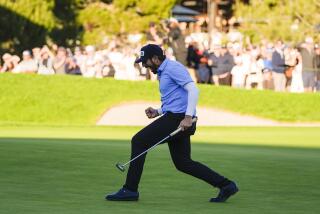Cypress Company Basks in Glow of Corey Pavin’s Open Victory
- Share via
As Corey Pavin strolled up Shinnecock Hills’ 18th fairway last Sunday, he threw his fist into the air, exuberant that the U.S. Open golf championship was his for the taking.
Pavin wasn’t the only one celebrating. In the headquarters of his corporate sponsors, the wheels were turning. By dawn the next day the assault had begun.
The U.S. was about to find out the real story behind Pavin’s victory. It wasn’t about Pavin’s talent that won him 11 PGA Tour victories in his 12-year career.
On Monday morning, the U.S. was being told it was Pavin’s golf clubs and golf ball that enabled him to win.
The maker of Pavin’s clubs, Cypress-based Cleveland Golf, had its own explanation for the victory.
On his approach shot at the 18th, Pavin stood 228 yards from the pin and bravely decided to go for broke. His shot--made possible, as Cleveland officials imply in their release, by the company’s Vas 4 Wood--rolled to within five feet of the hole.
In its release, Cleveland called it “the greatest shot in U.S. Open history.”
“Companies like to be associated with winners,” said Eric Wright, an executive with Joyce Julius & Associates, an Ann Arbor, Mich., firm that tracks brands images at major sporting events. “It gives them a positive image and influences the buyer when they go looking for a product.”
Wright’s firm found that during the Open’s final round, Cleveland Golf’s logo received just over 10 1/2 minutes of television time, or the equivalent of just over $1 million in media exposure.
That’s the good news. The bad news is that the word “golf” written under the word “Cleveland” on Pavin’s cap was too small to read. Some viewers might have thought it was Pavin showing his affinity for the city in Ohio.
“I’m sure people in the golf world know what Cleveland is, but logos are also put there to catch the eye of the uninformed,” said Raymond Howland, head of Joyce Julius’s golf tracking division. “The company has to redesign the logo to make the word golf more visible to the viewer.”
Why is it important that a logo is recognizable? There are more than a billion reasons.
The Sporting Goods Manufacturers Association in Mount Prospect, Ill., said $1.342 billion was spent on golf equipment in 1994. Of that total, $652 million was spent on golf clubs and another $316 million went to golf ball purchases.
Naturally, another firm said it was the high-tech design of Pavin’s Titleist ball that gave him an advantage over other golfers.
“Through the beguiling winds of Shinnecock Hills, Pavin once again counted on the consistent spin, feel and control of the Titleist golf ball to achieve tournament success, securing his victory with a purely struck approach shot through a difficult crosswind on the final hole of the championship,” the Fairhaven, Mass., company said in its Monday release.
Company officials took it even further, pointing out that Pavin’s win sent Titleist’s earnings on the 1995 PGA Tour to $23 million.
More to Read
Go beyond the scoreboard
Get the latest on L.A.'s teams in the daily Sports Report newsletter.
You may occasionally receive promotional content from the Los Angeles Times.









